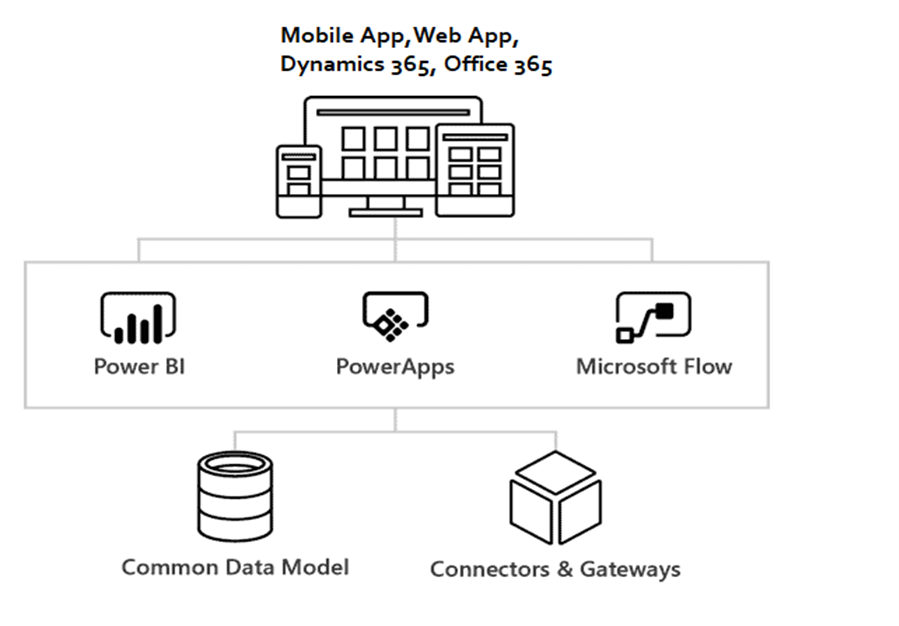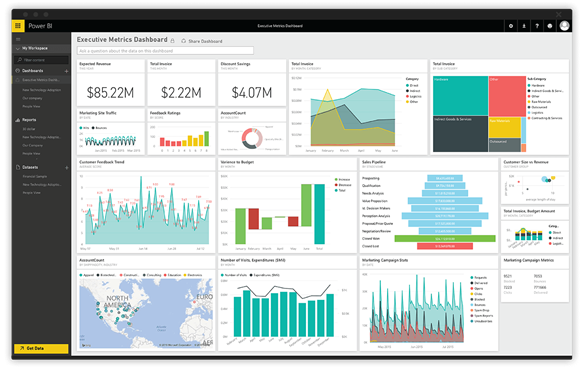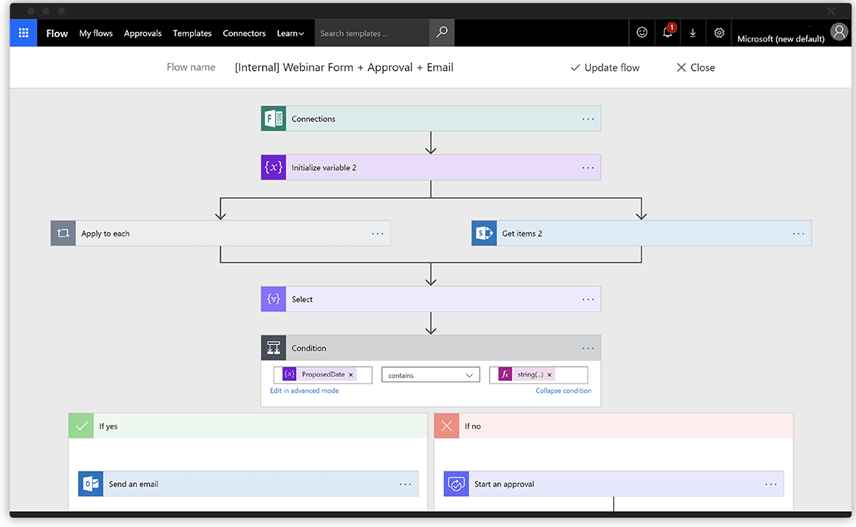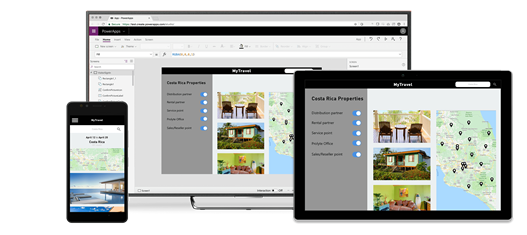Microsoft rapidly innovates, updates, and releases new products and solutions, which can make staying on top of changes difficult. This frequent pace of innovation makes Microsoft technologies very appealing. One of Microsoft's big new areas that is constantly making headlines is the Power Platform.
What is the Microsoft Power Platform?
Power Platform binds the superiority of Power-BI, Power-Automate, Power-Apps into a single potent business application platform that implements fast and straightforward app building and data insights. Every component of the Microsoft Power Platform is made on the Common Data Service for Apps. Each component is dynamic by itself but smart and masterful when together.
It provides help to easily manipulate, surface, automate, and analyze data. It is used with Office 365 and Dynamics 365, other third-party apps, and other Microsoft services.
The Microsoft Power platform brings all your data in sync into a common data model.
The Power Platform consists of 4 applications:
- Power BI: Displaying your business data in interactive, real-time dashboards and reports to supply detailed insights.
- Flow: Multi-stage automated workflows that hook-up with many apps and services.
- PowerApps: Create custom, no-code desktop & mobile applications running off your data.
- Power Virtual Agents: Easily build chatbots to interact conversationally along with your customers and employees—no coding required.
These applications handle your data by using Microsoft's Common Data Service (CDS).

Power Platform Overview
What is Common Data Service?
The core of the Microsoft Power Platform is the Common Data Service for Apps (CDS).
CDS helps you securely store and manage data utilized by business applications. Data inside CDS is stored within a collection of entities.
An entity is a bunch of records used to hold data, like how a table has data within a database.
CDS encompasses many normal entities that cover standard scenarios, but you can also create customized entities particular to your organization and populate them with data using Power Query. App makers can then use Power Apps to construct rich applications using this data.
Why use Common Data Service?
The entities (standard and custom entities) in CDS allow secure and cloud-based storage choice for your data used by business applications. Entities will enable you to create a business-focused definition of your organization's data to be used inside apps. If you are unsure if entities are your best choice, consider these advantages:
- Easy to manage: Both the metadata and data are saved within the cloud.
- Easy to secure: Data is securely stored so that users can see it on condition that you grant them access. Role-based security permits you to manage access to entities for various users within your organization.
- Access your Dynamics 365 Data: Data from your Dynamics 365 applications is additionally stored within the CDS, allowing you to quickly build apps that leverage your Dynamics 365 data and expand your apps using Power Apps.
- Rich metadata: Data types and relationships are leveraged directly within Power Apps.
- Logic and validation: Define calculated fields, business rules, workflows, and business process flows to confirm data quality and drive business processes.
- Productivity tools: Entities are available inside the add-ins for Microsoft Excel to increase productivity and ensure data accessibility.
Integrating Data into the Common Data Service:
CDS permits data to be integrated from multiple sources into one store, which might then be employed in Power Apps, Power Automate, Power BI, and Power Virtual Agents, together with data already present from the Dynamics 365 applications.
- Planned integration with other systems: In another application where data has been placed, which is also consistently synchronized with the CDS, it permits you to benefit other applications data in Power-Apps.
- Convert and import data using Power Query: Transforming data when importing into the CDS is done using Power Query from many online data sources, a standard tool used across Excel and Power BI.
- One-time import of knowledge: Straightforward import and export of Excel and CSV files are used for a one-time or infrequent import of data into the CDS.
Power BI
Being one of the leading business analytics tools, Power BI lets us connect easily to the data sources, create visuals, and gain business intelligence. Some of its features are:
- It represents data in an easy-to-digest format with data manipulation and visual creations like charts, maps, dashboards, etc.
- Easy connection with Microsoft and third-party services, be it cloud or on-premise data sources
- Usage of Natural Language for data querying and getting the output
- Easy Analysis of medium to complex data for continued improvements

Power BI
Microsoft Flow
Power Automate is Microsoft's push to automate workflows between the services of Microsoft or third-party applications. It prevents the staff from carrying out repetitive tasks and saves time. Power Automate was earlier known as Microsoft Flow.
Some of its features are:
- It provides pre-built automation for creating common automation, making it easier for developers (within the Flow Gallery).
- Create your automation by connecting various applications, such as Outlook, SharePoint Dynamics 365, or non-Microsoft apps like Twitter, Asana, Gmail, Mail Chimp, etc.
- Alerts, triggers, alerts, push notifications, automated emails, and much more things can be set up with no coding.
- Copy or move the business data on a schedule between systems.
- Almost 300 data sources available, and one can connect them through APIs.
- In a nutshell, it helps us save time, minimize human errors and streamline the processes.

Flow creation
Who is Power Automate for?
Anyone can use power Automate from a primary business user to an IT professional. One can utilize Power Automate's no-code/low-code platform for creating automated processes.
Power Automate has uses in several industries. Listed below are examples of some of the industries:
Types of flows:
Flow type Use case Automation target Automated flows Create automation triggered by an event such as the arrival of an email from a specific person. Enabling communication between your account with cloud or on-premise services. Instant flows Start automation with a click, and you can automate all repetitive tasks like send a reminder, etc. Wide range of tasks such as requesting an approval, an action in Teams, or SharePoint. Schedule flows Schedule an automated task such as upload data daily to SharePoint or a database. Tasks that can be automated and should run on a schedule. Business processes flow Ensuring that the business process being followed by everyone in the company is the same by stating steps for them to adhere to. Any processes that require human interaction like IT development, approvals, customer service requests, etc. UI flow Register and record keypress and clicks from Web applications or computer and automate the playback of manual steps on legacy software. Any personal computer, laptop, or Web application that doesn't have APIs for automation available with it. PowerApps
PowerApps is one of the most popular ways to develop a custom application with lesser code to write, enabling users and developers to easily and quickly create applications.
Power Apps are often used for multiple processes regarding workflow, automation, data visualization, and reporting, collaboration, and more. It could involve teams, field workers, management team, and even your customers. Use cases can range from the nearly simple to the highly complex.
Some of its features are:
- Connecting your business applications with the surface data; Dynamics 365 and Office 365 as well as with the third-party apps.
- Creating Applications that are platform-independent and mobile-friendly, with its ability to provide a ready-made framework, helps us create them easily.
Placing only critical data into a user-friendly application helps data entry so that users only see the key information they must know to fulfill a task.

Power Apps
The Applications that are built using Power Apps provide enhanced workflow capabilities and business logic of excellent quality. It helps in transforming manual processes in business to automated digital processes.
Also, Power Apps lets our app have a responsive design compatible with all screen sizes and browsers.
Power Virtual Agents
Power Virtual Agents helps you form powerful chatbots that answer your website or service questions asked by customers, employees, or visitors.
These bots could also be created easily without the need for data scientists or developers. Variety of the ways within which Power Virtual Agents bots are used include:
- COVID-19 infection rate and tracking information system
- Support issues and Sales help
- Store information and Opening hours
- Vacation benefits and Employee health
- General employee questions for businesses
Power Virtual Agents is out there as both a standalone web app and as a discrete app within Microsoft Teams. Most of the functionality between those is the same. However, there can be different reasons to settle on one version or another based on how you want to use Power Virtual Agents.
Power Virtual Agents version Use cases Web app - You are an IT admin and wish to form bots for your customers to interact with.
- You have used chatbot services within the past and need to trial or test Power Virtual Agents.
- You are conversant in advanced chatbot concepts, like entities and variables, and need to make complex chatbots.
Microsoft Teams app - Employee or member of a corporation or team and needs to form chatbots to answer common questions posed by other employees or teammates.
- Want to use advanced concepts, like entities and variables, but have the chatbot available only internally.
- Want to make and distribute a chatbot within the shortest time possible.













